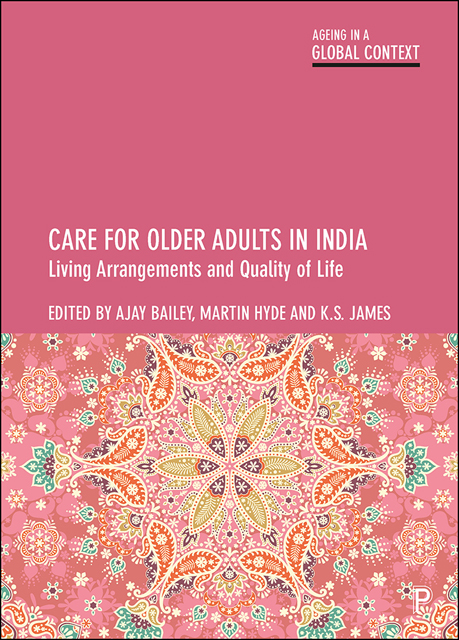Book contents
- Frontmatter
- Contents
- List of figures and tables
- Notes on the editors
- List of contributors
- Acknowledgements
- Series editors’ preface
- Map of India
- 1 Introduction: Living arrangements and care in India
- 2 Theorising care and relationships in the age of migration
- 3 Emerging living arrangements of older adults in India: patterns and welfare implications
- 4 Living arrangement concordance and the well-being of older persons in India
- 5 Family size and living arrangements among older adults in Kerala: panel data analysis, 2004– 19
- 6 Care arrangements for older adults: exploring the intergenerational contract in emigrant households of Goa, India
- 7 All my responsibilities towards my children are over! Linked lives and life course obligations among older adults with migrant children in India
- 8 Interpreting the landscapes of care for older men in Delhi and Kolkata: perspectives from care receivers and caregivers
- 9 The role of cultural meaning system and place attachment in retaining home ownership while residing in retirement homes in Kerala, India
- 10 Decision-making and choice or sine qua non? Care home entry in Tamil Nadu
- 11 Welfare and development programmes for older adults in India
- 12 Lessons and future directions for caregiving research in India
- Index
5 - Family size and living arrangements among older adults in Kerala: panel data analysis, 2004– 19
Published online by Cambridge University Press: 13 October 2022
- Frontmatter
- Contents
- List of figures and tables
- Notes on the editors
- List of contributors
- Acknowledgements
- Series editors’ preface
- Map of India
- 1 Introduction: Living arrangements and care in India
- 2 Theorising care and relationships in the age of migration
- 3 Emerging living arrangements of older adults in India: patterns and welfare implications
- 4 Living arrangement concordance and the well-being of older persons in India
- 5 Family size and living arrangements among older adults in Kerala: panel data analysis, 2004– 19
- 6 Care arrangements for older adults: exploring the intergenerational contract in emigrant households of Goa, India
- 7 All my responsibilities towards my children are over! Linked lives and life course obligations among older adults with migrant children in India
- 8 Interpreting the landscapes of care for older men in Delhi and Kolkata: perspectives from care receivers and caregivers
- 9 The role of cultural meaning system and place attachment in retaining home ownership while residing in retirement homes in Kerala, India
- 10 Decision-making and choice or sine qua non? Care home entry in Tamil Nadu
- 11 Welfare and development programmes for older adults in India
- 12 Lessons and future directions for caregiving research in India
- Index
Summary
Introduction
The onset of disability is a natural part of the ageing process. However, this can often lead to the need for care. In India, it has been a traditional practice that older adults obtain socio-economic support and health care from a family caregiver, usually from their children, spouse or immediate family members (Ugargol et al, 2016). Hence, the household living arrangements of older people in India are seen as important for the availability of family support. Kerala is one of the states in India that has undergone rapid demographic transition (Liebig and Rajan, 2003; Guilmoto and Rajan, 2005). Due to the decrease in infant mortality rates and increases in average life expectancy, both of which are comparable to some developed nations, Kerala is reported to have the highest proportion of older adults in its population in India (Bhat and Rajan, 1990; Rajan, 1989; Rajan, Mishra and Sarma, 1999; Rajan and Sunitha, 2018). According to the 2011 Census, 12.6 per cent of the population were aged 60 and over and this proportion is increasing at a rate of 2.3 per cent per year (Rajan and Mishra, 2014). By 2026, the state will have 6.8 million older adults, up from 5.9 million in 2021, which will constitute approximately 16 per cent of the total population (Rajan and Mishra, 2020). In addition, Kerala has also experienced large internal and international migration (about 10 per cent of the population) of younger age groups which led many households to be without an adult member of ‘working age’. It is assumed that this will have serious implications for care and living arrangements among older people in Kerala.
Living arrangements of older adults in India
The 2011 Census revealed that the average household size in India was 4.5 and the average number of older adults in a household was 2.4. This reflects the traditional image of the Indian family that has two older individuals who are looked after in the home. Also, it was found that the number of single-person older households increased during the inter-census period 2001– 11 (Rajan and Sunitha, 2019). Figures from the Longitudinal Ageing Survey in India (LASI) in 2017– 18 show that 5.1 per cent of older adults are living alone.
- Type
- Chapter
- Information
- Care for Older Adults in IndiaLiving Arrangements and Quality of Life, pp. 69 - 85Publisher: Bristol University PressPrint publication year: 2022

